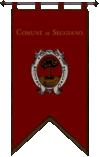Seggiano
| Seggiano | ||
|---|---|---|

|
|
|
| Country | Italy | |
| region | Tuscany | |
| province | Grosseto (GR) | |
| Coordinates | 42 ° 56 ' N , 11 ° 33' E | |
| height | 491 m slm | |
| surface | 49.53 km² | |
| Residents | 990 (Dec. 31, 2019) | |
| Population density | 20 inhabitants / km² | |
| Post Code | 58038 | |
| prefix | 0564 | |
| ISTAT number | 053025 | |
| Popular name | Seggianesi | |
| Patron saint | San Bartolomeo (August 24th) | |
| Website | Seggiano municipality | |
 Panorama of Seggiano |
||
Seggiano is a municipality with 990 inhabitants (as of December 31, 2019) in the province of Grosseto , Tuscany region in Italy .
geography
The community extends over around 50 km² . It is about 40 km northeast of Grosseto and 100 km south of Florence near Monte Amiata . The municipality is located in the Orcia Valley and in the Montecucco wine-growing region . The rivers Ente , Vetra and Vivo cross the municipality. In the climatic classification of Italian municipalities , the place is in Zone E, 2204 GG.
The only district is the village of Pescina, about three km to the southeast, at the foot of the Amiata. It is 747 meters above sea level and has around 150 inhabitants.
The neighboring communities are Abbadia San Salvatore ( SI ), Castel del Piano and Castiglione d'Orcia (SI).
history
The place is mentioned for the first time in 903 as the property of the abbey in Abbadia San Salvatore and then came under the control of the Salimbeni from Siena at the beginning of the 13th century to the Abbey of Sant'Antimo and in the second half of the 13th century . From the 15th century until the defeat of the Senese Republic in 1555 by the Republic of Florence , Seggiano was under the influence of the Ugurgeri, who also came from Siena . After that the place also fell to the Duchy of Tuscany (like Siena) .
Attractions
- Castello del Potentino , approx. 1 km southwest of Seggiano on the river Vivo. Was first mentioned in 1042 and came under the influence of the Bishop of Chiusi at the beginning of the 13th century through Otto IV . Surrendered to the Republic of Siena in 1213, but continued to maintain contacts with the Abbadia San Salvatore Abbey and the Aldobrandeschi. It fell permanently to Siena in the 15th century and served as the outpost of Santa Maria della Scala .
- Chiesa del Corpus Domini , resulting in the 18th century church . Was restored in 1869
- Chiesa di San Bartolomeo , church from 1216, restored in 1860. Contains the work Madonna col Bambino in trono ei Santi Bartolomeo, Giovanni Evangelista e Michele Arcangelo by Bartolomeo Bulgarini
- Chiesa di Santa Maria in Villa , church restored in 1486, probably of older origin, contains the work Madonna col Bambino by Andrea Vanni .
- Convento del Colombaio , already mentioned in 1251 the Franciscan convent .
- Il Giardino , sculpture garden by the artist Daniel Spoerri with sculptures by Spoerri and around 40 artist friends
- Oratorio di San Rocco , oratory just outside the city walls near the Porta del Mercato. Made between 1486 and 1490. Inside there are frescos by the Senese artist Girolamo di Domenico (1493).
- Santuario della Madonna della Carità , a sanctuary built between 1588 and 1603 just outside the city walls.
literature
- Giuseppe Guerrini / Amministrazione Provinciale di Grosseto: Torri e Castelli della provincia di Grosseto. Nuova Immagine Edizioni, Siena 1999, ISBN 88-7145-154-6 .
- Lucio Niccola / Fiora Bonelli: Paesi dell'Amiata , Cesare Moroni Edizioni, 2003, pp. 103-114.
- Felicia Rotundo / Bruno Santi: Seggiano. In: Bruno Santi: Guida Storico-Artistica alla Maremma. Nuova Immagine Edizioni, Siena 1995, ISBN 88-7145-093-0 .
- Emanuele Repetti: Dizionario Geografico Fisico Storico della Toscana Online edition of the University of Siena on the municipality of Seggiano
- Bruno Santi: I luoghi della Fede. L'Amiata e la Val d'Orcia , Arnoldo Mondadori Editore , Milan 1999, ISBN 88-04-46780-0 , pp. 169-175.
- Touring Club Italiano : Toscana. Milan 2003, ISBN 88-365-2767-1 , p. 688.
Web links
Individual evidence
- ↑ Statistiche demografiche ISTAT. Monthly population statistics of the Istituto Nazionale di Statistica , as of December 31 of 2019.
- ↑ Official website of the Sistema Informativo Ambientale della Regione Toscana (SIRA) on the rivers in Seggiano , accessed on March 5, 2013 (ital.)
- ↑ Website of the Agenzia nazionale per le nuove tecnologie, l'energia e lo sviluppo economico sostenibile (ENEA), accessed on October 28, 2012 (Italian) (PDF; 330 kB)
- ↑ Official website of the ISTAT ( Istituto Nazionale di Statistica ) on the 2001 population figures in the province of Grosseto, accessed on October 28, 2012 (Italian)
- ↑ cf. Guerrini p. 128



